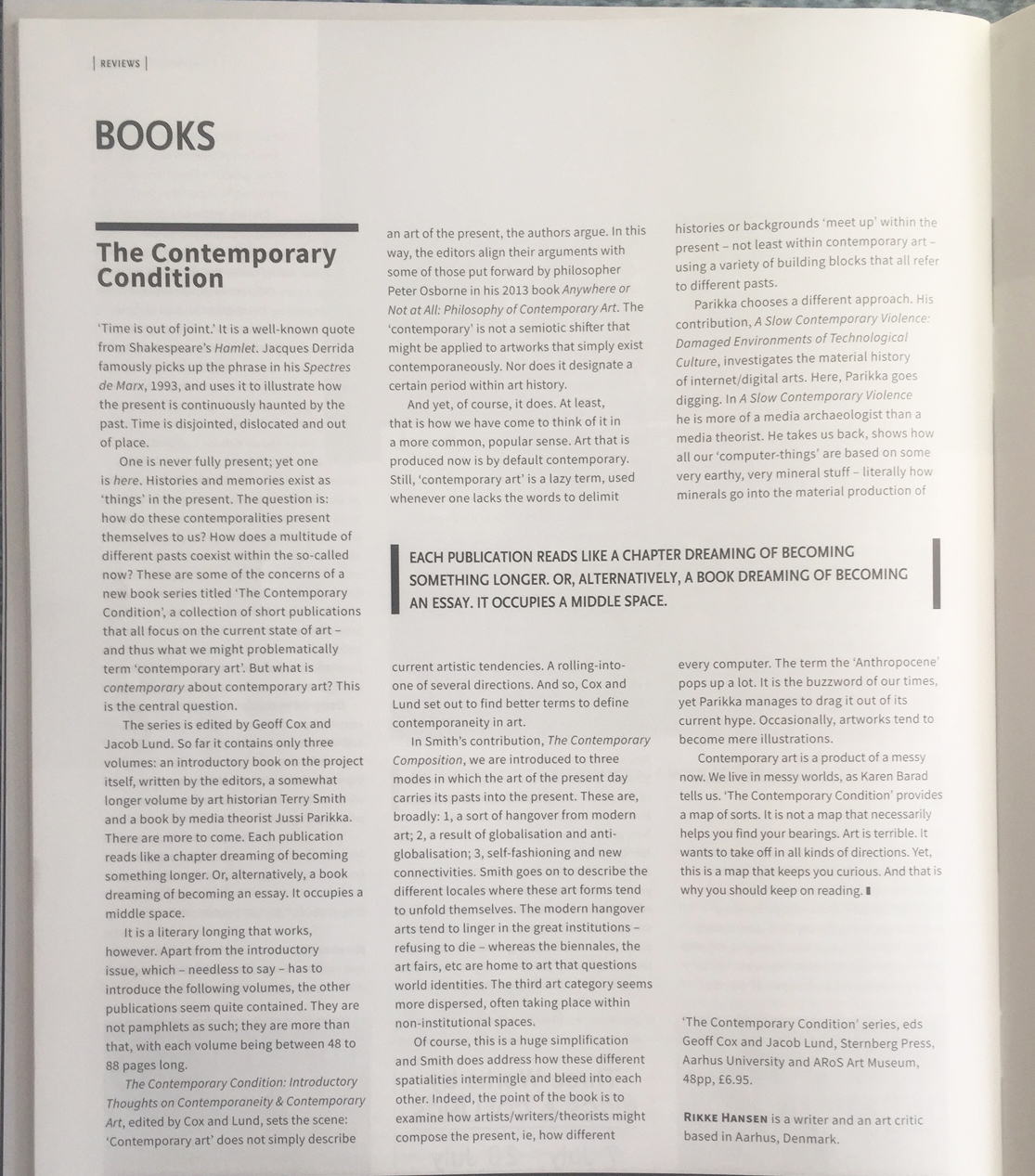Review of TCC book series by Rikke Hansen, in Art Monthly 408: Jul-Aug 2017
“Each publication reads like a chapter dreaming of becoming something longer. Or, alternatively, a book dreaming of becoming an essay. It occupies a middle space.”

‘Time is out of joint.’ It is a well-known quote from Shakespeare’s Hamlet. Jacques Derrida famously picks up the phrase in his Spectres de Marx, 1993, and uses it to illustrate how the present is continuously haunted by the past. Time is disjointed, dislocated and out of place.
One is never fully present; yet one is here. Histories and memories exist as ‘things’ in the present. The question is: how do these contemporalities present themselves to us? How does a multitude of different pasts coexist within the so-called now? These are some of the concerns of a new book series titled ‘The Contemporary Condition’, a collection of short publications that all focus on the current state of art – and thus what we might problematically term ‘contemporary art’. But what is contemporary about contemporary art? This is the central question.
The series is edited by Geoff Cox and Jacob Lund. So far it contains only three volumes: an introductory book on the project itself, written by the editors, a somewhat longer volume by art historian Terry Smith and a book by media theorist Jussi Parikka. There are more to come. Each publication reads like a chapter dreaming of becoming something longer. Or, alternatively, a book dreaming of becoming an essay. It occupies a middle-space.
It is a literary longing that works, however. Apart from the introductory issue, which – needless to say – has to introduce the following volumes, the other publications seem quite contained. They are not pamphlets as such; they are more than that, with each volume being between 48 to 88 pages long.
The Contemporary Condition: Introductory Thoughts on Contemporaneity & Contemporary Art, by Cox and Lund, sets the scene: ‘Contemporary art’ does not simply describe an art of the present, the authors argue. In this way, the editors align their arguments with some of those put forward by philosopher Peter Osborne, in his 2013 book Anywhere or Not at All: Philosophy of Contemporary Art. The ‘contemporary’ is not a semiotic shifter that might be applied to artworks that simply exist contemporaneously. Nor does it designate a certain period within art history.
And yet, of course, it does. At least, that is how we have come to think of it in a more common, popular sense. Art that is produced now is by default contemporary. Still, ‘contemporary art’ is a lazy term, used whenever one lacks the words to delimit current artistic tendencies. A rolling-into-one of several directions. And so, Cox and Lund set out to find better terms to define contemporaneity in art.
In Terry Smith’s contribution, The Contemporary Composition, we are introduced to three modes in which the art of the present day carries its pasts into the present. These are, broadly speaking: 1, a sort of hangover from modern art; 2, a result of globalisation and anti-globalisation; 3, self-fashioning and new connectivities. Smith goes on to describe the different locales where these art forms tend to unfold themselves. The modern hangover arts tend to linger in the great institutions – refusing to die – whereas the biennales, the art fairs, etc are home to art that questions world identities. The third art category seems more dispersed, often taking place within non-institutional spaces.
Of course, this is a huge simplification and Smith does address how these different spatialities intermingle and bleed into each other. Indeed, the point of the book is to examine how artists/writers/theorists might compose the present, ie, how different histories or backgrounds ‘meet up’ within the present – not least within contemporary art – using a variety of building blocks that all refer to different pasts.
Parikka chooses a different approach. His contribution, A Slow Contemporary Violence: Damaged Environments of Technological Culture, investigates the material history of internet/digital arts. Here, Parikka goes digging. In A Slow Contemporary Violence, he is more of a media archaeologist than a media theorist. He takes us back, shows how all our ‘computer-things’ are based on some very earthy, very mineral stuff – literally how minerals go into the material production of every computer. The term the ‘Anthropocene’ pops up a lot. It is the buzzword of our times, yet Parikka manages to drag it out of its current hype. Occasionally, artworks tend to become mere illustrations.
Contemporary art is a product of a messy now. We live in messy worlds, as Karen Barad tells us. ‘The Contemporary Condition’ provides a map of sorts. It is not a map that necessarily helps you find your bearings. Art is terrible. It wants to take off in all kinds of directions. Yet, this is a map that keeps you curious. And that is why you should keep on reading.
The Contemporary Condition: Introductory Thoughts on Contemporaneity & Contemporary Art, Geoff Cox and Jacob Lund eds, Sternberg Press, Aarhus University and ARoS Art Museum, 2016, 48pp, £6.95, 978 3 956792 81 6.
Rikke Hansen is a writer and an art critic based in Aarhus, Denmark.
